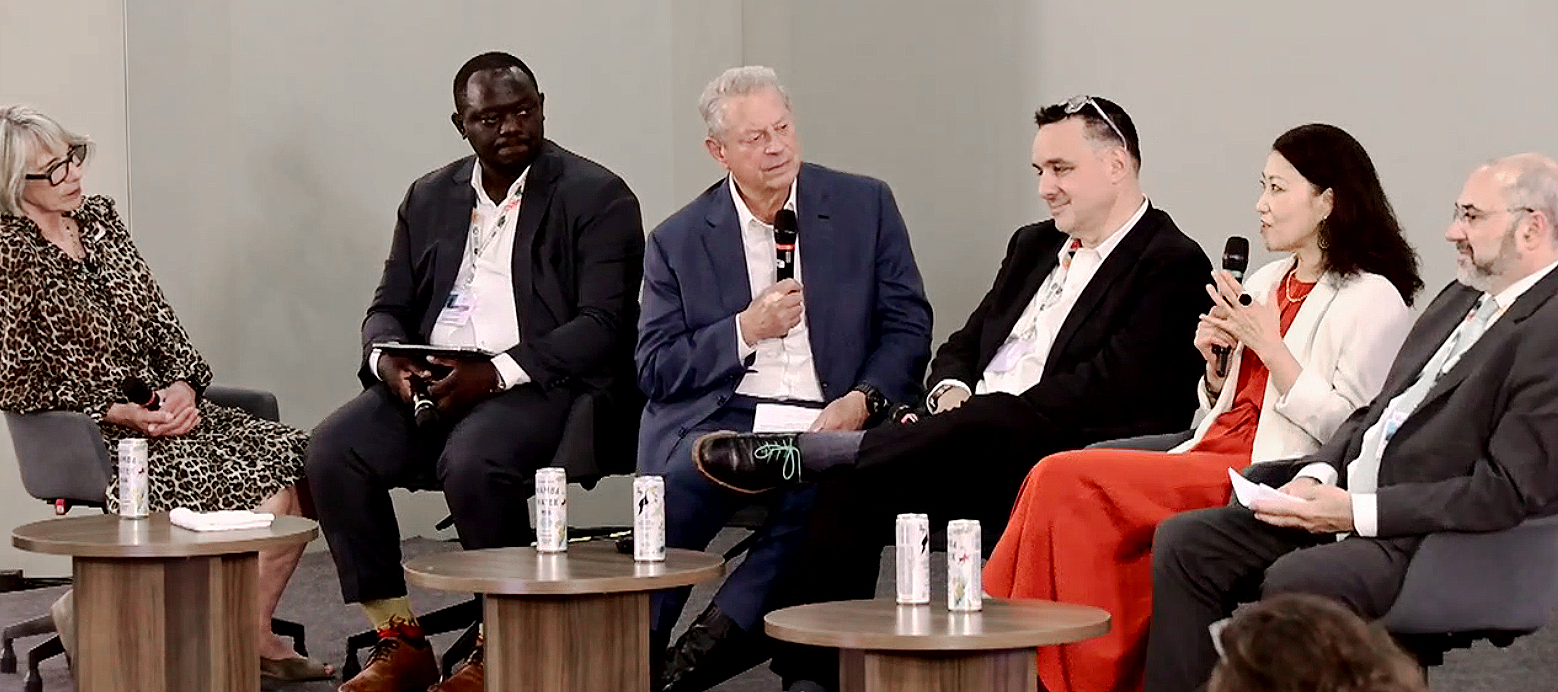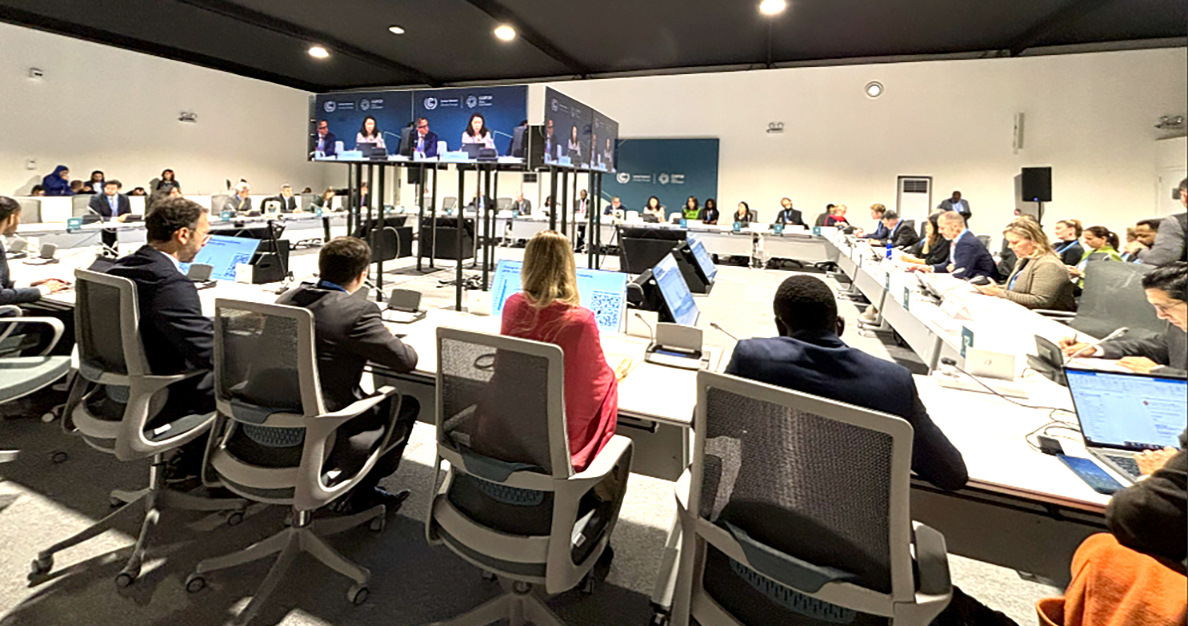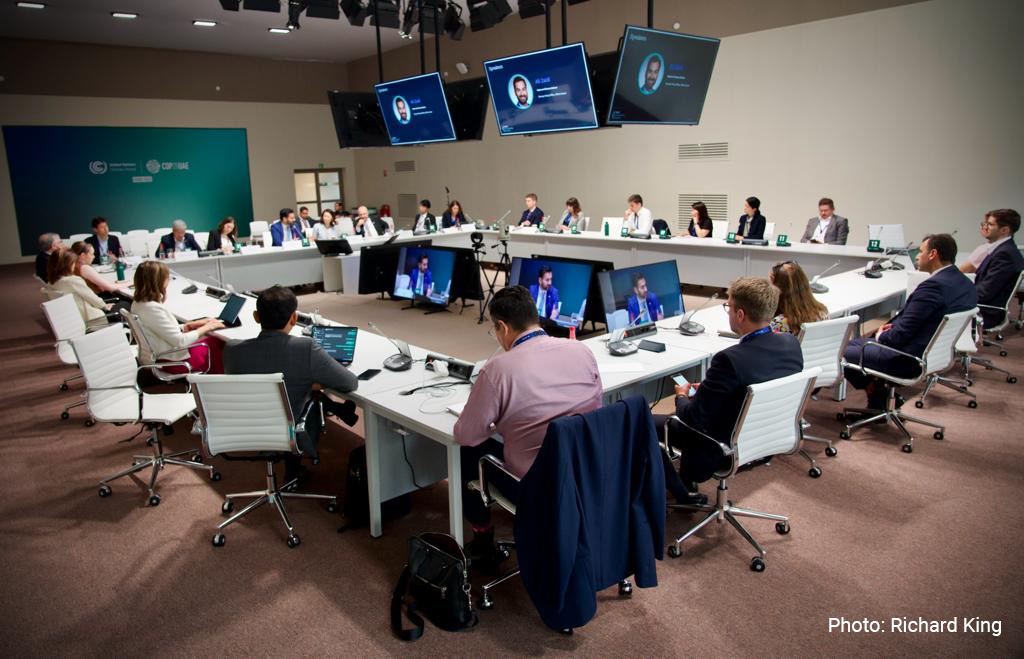Key findings
- A data-driven approach can help countries implement climate targets while supporting private investment in the energy transition.
- Investors increasingly want to assess both physical risk and policy at a local level.
- Aligning real-time emissions and location-specific data could transform transparency in energy-transition finance and accelerate countries’ climate action.

Linda-Eling Lee, the MSCI Institute’s founding director (second from right), discusses the use of data-driven analytics in climate investing with, left to right, Jane Lomax, lord mayor of Adelaide, Australia; David Gonahasa, an economist with Uganda’s Ministry of Science, Technology and Innovation; Al Gore, the former U.S. vice president and a co-founder of Climate TRACE; Andrew Zolli, chief impact officer, Planet Labs; and James Grabert, mitigation director, UNFCCC.
The use of data-driven analytics can speed the ability of countries to implement their climate targets and transform energy-transition finance.
That was the focus of a conversation hosted by the U.N. Framework Convention on Climate Change (UNFCCC) and the Climate TRACE coalition that took place at United Nations COP30 summit in Belém, Brazil on Wednesday.
The conversation, moderated by Al Gore, the former U.S. vice president and a co-founder of Climate TRACE, featured leaders from technology, investment data and policymaking who came together to discuss how asset-level analytics powered by satellite imaging, remote sensing, and artificial and geospatial intelligence can transform transparency in emissions reporting and accelerate implementation of climate targets by countries worldwide.
Here are some of the insights shared.
Accelerating action
Countries’ climate targets, as expressed in their nationally determined contributions (NDCs), “are a compass,” said James Grabert, the UNFCCC’s director of mitigation, but gaps in access to reliable data mean that “some countries are flying blind.”
- Linda-Eling Lee, the MSCI Institute’s founding director, explained that data-driven decision-making ties directly the ability of investors to measure and manage their exposure to climate risk so they can better price that risk and direct capital to companies that are positioned to succeed in a low-carbon economy. “What’s underappreciated is that there is a huge lag from the time emissions occur to when a company reports and when investors have the full picture,” she noted, adding that the world’s investable companies contribute roughly a third of global emissions.
- “You can’t fix what you can’t measure,” observed David Gonahasa, an economist with Uganda’s Ministry of Science, Technology and Innovation, which is participating in a pilot sponsored by the UNFCCC that offers countries the opportunity to enhance NDC preparation and implementation of climate targets using Earth observation data and analytics. “Action has to be bottom up with locals as part of the solution,” he added.
- Jane Lomax, lord mayor of Adelaide, Australia, stressed that policymakers need data to help them explain investments in adaptation and resilience, such as spending money to put trees on streets or purchase heat-resilient infrastructure. “Democratizing the data and explaining what you’re doing helps to ensure that everyone knows why we’re spending money to future-proof our city,” she said.
- As with any satellite, “we have to measure the forces of change that are acting on Earth,” observed Andrew Zolli, chief impact officer at Planet Labs, which operates satellites that produce high-resolution images of Earth. Satellite images coupled with artificial intelligence enable climate action in a variety of ways that include measuring and verifying carbon projects, detecting methane leaks (he cited work by Carbon Mapper, a nonprofit deploying satellites to detect methane plumes), and spotting signals of deforestation, he explained.
Identifying gaps
“Decisions about climate finance should be and are data driven but sometimes don’t take important factors into account,” noted Al Gore, who asked what data may be missing from investment and policy conversations.
- “When it comes to data for pinpointing where risks and opportunities lie, it’s location that drives financial outcomes,” Linda-Eling Lee explained. “That’s not just physical risk, but also the policy landscape at both the national and subnational levels.” Two factories producing emissions may each have very different transition costs and opportunities depending on the jurisdiction and the carbon rules, clean-technology subsidies or trade policies in each. “Investors are demanding both sides of the location story,” she stressed.
- “Models don’t always give us a longer term picture of how risk can spiral,” noted the UNFCCC’s James Grabert. “We also should be rethinking how we measure impact,” he suggested, noting the need for data that captures systemic changes resulting from a warming world.
- Subnational governments need data as well, said Jane Lomax, who noted that local governments “have boots on the ground and shovels ready” for resilience measures tied to storm water and dangerous heat but operate at a data deficit compared with national governments.
- Data also can help to combat misinformation, she stressed. “Everyone wants to be on a clean planet that survives,” she said. “Maybe we need to do better in showing that climate action is not about electrification alone but about protecting the environment.” Al Gore agreed, praising Brazil’s President Luiz Inácio Lula da Silva for his goal to make COP30 the COP of truth.
Speeding climate action
If you could change one thing to speed climate action, what it would be, Gore asked.
- “Eliminate the time mismatch between climate risk data and financial data,” said Linda-Eling Lee. “If policymakers and investors could see emissions and financial impact in sync, it would create a positive feedback loop and change immediately how climate capital is deployed.”
- “Put the best analytical tools and the most advanced capacity in the hands of developing countries,” advised James Grabert. “That’s why we’re thrilled by Uganda’s stepping up.”
- “Reduce the complexity of the development process for climate solutions and get people involved,” urged David Gonahasa.
- “Electrify our public transportation fleets,” said Jane Lomax, noting the sprawl of Australia’s cities and the distances between them.
- Andrew Zolli called for satellites that are detecting emissions. “Let’s take the power of the private sector to fund them.”
MSCI and Climate TRACE have teamed to help investors improve measurement of greenhouse gas emissions by combining Climate TRACE’s use of satellites, remote sensing and AI with MSCI GeoSpatial Asset Intelligence, Lee noted. “We are on the cusp of a revolution in transparency that comes from linking real-time emissions data to the financial value of assets for companies and investors,” she said.


